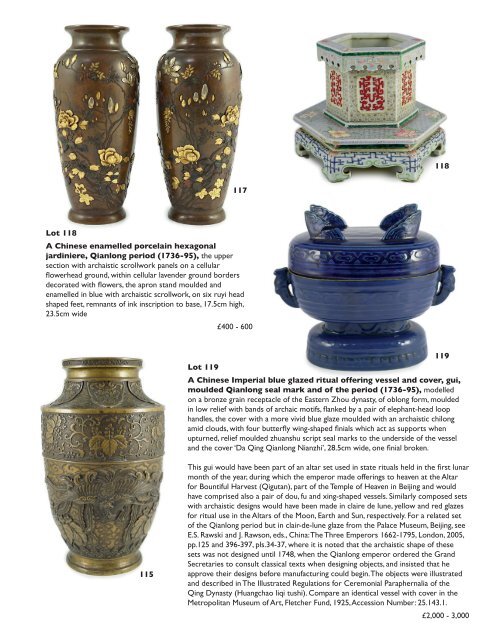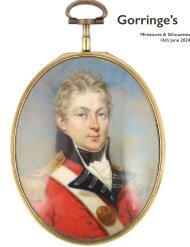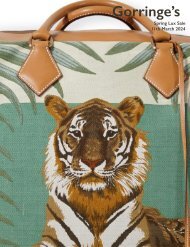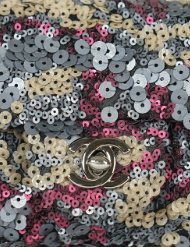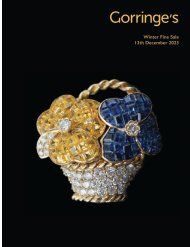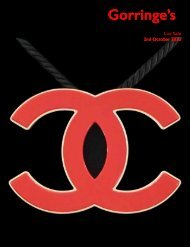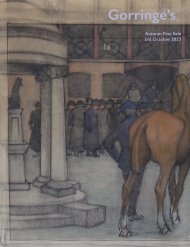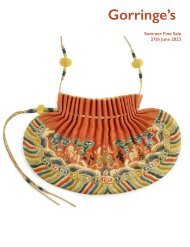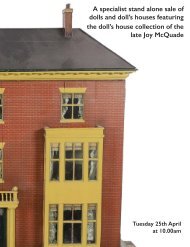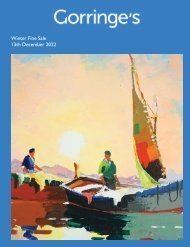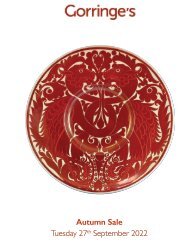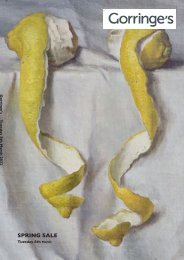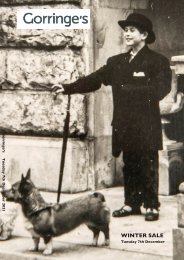Gorringe's Spring Fine Sale 14th March 2023
You also want an ePaper? Increase the reach of your titles
YUMPU automatically turns print PDFs into web optimized ePapers that Google loves.
118<br />
117<br />
Lot 118<br />
A Chinese enamelled porcelain hexagonal<br />
jardiniere, Qianlong period (1736-95), the upper<br />
section with archaistic scrollwork panels on a cellular<br />
flowerhead ground, within cellular lavender ground borders<br />
decorated with flowers, the apron stand moulded and<br />
enamelled in blue with archaistic scrollwork, on six ruyi head<br />
shaped feet, remnants of ink inscription to base, 17.5cm high,<br />
23.5cm wide<br />
£400 - 600<br />
Lot 119<br />
119<br />
A Chinese Imperial blue glazed ritual offering vessel and cover, gui,<br />
moulded Qianlong seal mark and of the period (1736-95), modelled<br />
on a bronze grain receptacle of the Eastern Zhou dynasty, of oblong form, moulded<br />
in low relief with bands of archaic motifs, flanked by a pair of elephant-head loop<br />
handles, the cover with a more vivid blue glaze moulded with an archaistic chilong<br />
amid clouds, with four butterfly wing-shaped finials which act as supports when<br />
upturned, relief moulded zhuanshu script seal marks to the underside of the vessel<br />
and the cover ‘Da Qing Qianlong Nianzhi’, 28.5cm wide, one finial broken.<br />
115<br />
This gui would have been part of an altar set used in state rituals held in the first lunar<br />
month of the year, during which the emperor made offerings to heaven at the Altar<br />
for Bountiful Harvest (Qigutan), part of the Temple of Heaven in Beijing and would<br />
have comprised also a pair of dou, fu and xing-shaped vessels. Similarly composed sets<br />
with archaistic designs would have been made in claire de lune, yellow and red glazes<br />
for ritual use in the Altars of the Moon, Earth and Sun, respectively. For a related set<br />
of the Qianlong period but in clair-de-lune glaze from the Palace Museum, Beijing, see<br />
E.S. Rawski and J. Rawson, eds., China: The Three Emperors 1662-1795, London, 2005,<br />
pp.125 and 396-397, pls.34-37, where it is noted that the archaistic shape of these<br />
sets was not designed until 1748, when the Qianlong emperor ordered the Grand<br />
Secretaries to consult classical texts when designing objects, and insisted that he<br />
approve their designs before manufacturing could begin. The objects were illustrated<br />
and described in The Illustrated Regulations for Ceremonial Paraphernalia of the<br />
Qing Dynasty (Huangchao liqi tushi). Compare an identical vessel with cover in the<br />
Metropolitan Museum of Art, Fletcher Fund, 1925, Accession Number: 25.143.1.<br />
£2,000 - 3,000


